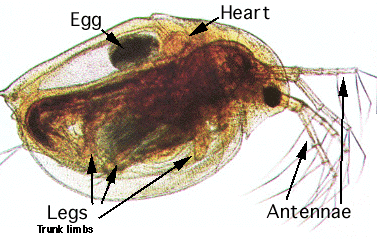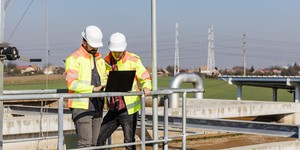Abstract
One way to test for the presence of toxic compounds in a water sample is a bioassay. In a bioassay, a living organism serves as a detector for toxins—the same way canaries were used in coal mines to detect invisible toxic gases. In this project, water fleas (Daphnia magna), a freshwater crustacean, are used in a bioassay to monitor water quality. Many variations of this experiment are possible.Summary
Andrew Olson, Ph.D., Science Buddies
Sources
This project is based on:
- Environmental Inquiry. (2009). Analyzing Daphnia Data. Cornell University and Penn State University. Retrieved October 3, 2013.
- Environmental Inquiry. (2009). Testing Environmental Samples Cornell University and Penn State University. Retrieved October 3, 2013.
Objective
To determine if sediment from parking lots contain compounds that are harmful for aquatic organisms.
Introduction
As human population centers grow to cover more and more of the planet, watersheds are increasingly affected by the presence of buildings, roadways, and parking lots. A watershed is "the area of land that catches rain and snow and drains or seeps into a marsh, stream, river, lake or groundwater." (EPA, 2006b.) This project asks the question: "Can run-off from parking lots be toxic to organisms in nearby ponds and streams?" You will learn how to conduct a bioassay to determine if sediments from a parking lot are toxic for aquatic organisms.
As the name suggests, a bioassay uses living organisms as the "detector" for an experimental procedure. When doing environmental testing for toxins, the bioassay is typically a viability assay. You count how many organisms are present at the beginning of the experiment, expose the organisms to different concentrations of the suspsected toxin, and count the number of organisms that remain viable. It is critically important to maintain a control population of the organisms, so that you don't mistake the naturally-occuring death rate of the organisms as the effect of toxins.
The organism that you will use for testing water toxicity is Daphnia magna. Daphnia magna (common name "water fleas") are tiny freshwater crustaceans. They are filter feeders, and can survive in culture by eating algae, bacteria, or yeast.
If you make a graph of the percentage of Daphnia that remain viable (y-axis) vs. the concentration of the compound tested (x-axis), you can determine the LC50 value for the compound. This is the concentration at which 50% of the population remains viable. It is one useful measure for comparing the relative toxicities of compounds.
Terms and Concepts
To do this project, you should do research that enables you to understand the following terms and concepts:
- bioassay,
- watershed,
- Daphnia magna,
- toxicity,
- LC50,
- environmental samples.
Questions
- What is the LC50 for a compound and how is it determined?
Bibliography
- Environmental Inquiry. (2009). Bioassays: Why Daphnia?. Cornell University and Penn State University. Retrieved October 3, 2013.
- Environmental Inquiry. (2009). Analyzing Daphnia Data. Cornell University and Penn State University. Retrieved October 3, 2013.
- Environmental Inquiry. (2009). Testing Environmental Samples. Cornell University and Penn State University. Retrieved October 3, 2013.
- Environmental Inquiry. (2009). Culturing Daphnia. Cornell University and Penn State University. Retrieved October 3, 2013.
- Clare, J.. (2002). Daphnia: An Aquarist's Guide. A Caudata.org website. Retrieved October 9, 2006.
- EPA. (2006a). ECOTOX Database. U.S. Environmental Protection Agency. Retrieved October 19, 2006.
- NLM. (2006). TOXNET Toxicology Data Network. U.S. National Library of Medicine. Retrieved October 19, 2006.
- EPA. (2006b). Surf Your Watershed. U.S. Environmental Protection Agency. Retrieved October 19, 2006.
Materials and Equipment
These items can be purchased from Carolina Biological Supply Company, a Science Buddies Approved Supplier:
- Daphnia magna culture kit. Alternatively, you could purchase Daphnia magna and other kit components separately, such as possibly from a local tropical fish store. The kit includes one culture of Daphnia magna, a 1.5-gal plastic culture aquarium, dried algal food, spring water (1 gal), and culturing instructions.
- Plastic watering pipettes. These are to move individual Daphnia from one container to another.
- Fine mesh small fish net. This is for catching and moving larger numbers of Daphnia.
- Spring water. Note: The Daphnia magna culture kit comes with spring water, but you can order additional spring water separately if needed. Alternatively, you can use dechlorinated tap water.
You will also need to gather these items:
- Broom and dustpan. These are for collecting sediment.
- Electronic balance for weighing collected sediment samples, such as the Fast Weigh MS-500-BLK Digital Pocket Scale, 500 by 0.1 G, available from Amazon.com
- Small containers. These are for holding your experimental and control groups before testing.
- Lab notebook
Disclaimer: Science Buddies participates in affiliate programs with Home Science Tools, Amazon.com, Carolina Biological, and Jameco Electronics. Proceeds from the affiliate programs help support Science Buddies, a 501(c)(3) public charity, and keep our resources free for everyone. Our top priority is student learning. If you have any comments (positive or negative) related to purchases you've made for science projects from recommendations on our site, please let us know. Write to us at scibuddy@sciencebuddies.org.
Experimental Procedure
- Do your background research so that you are knowledgeable about the terms, concepts, and questions in the Background tab.
- You will need to plan ahead for this experiment, because it takes time to order and receive the Daphnia magna, and to establish a stable culture of the organisms before testing can begin.
- Follow the instructions for culturing Daphnia that come with the culture kit. It is a good idea to keep two separate containers of Daphnia. If something goes wrong with one of them, you will have a back-up.
- Do not use plain tap water for your Daphnia cultures or test conditions. Most tap water contains chlorine and/or chloramine as a disinfectant. These compounds are lethal for Daphnia. Use spring water or dechlorinated tap water.
- Once your Daphnia culture is well-established, you are ready to conduct your bioassay. Collect sediment samples from a local parking lot. Take one of your parents along to look out for cars and keep you safe. You should also take notes on where each sample was collected (maybe take a photo), and label each sample.
- Weigh the sediment samples and record their weights in a data table in your lab notebook.
- Dilute the sediment samples with spring water at different concentrations, to simulate rainwater run-off after a storm. Label each container with concentration (in grams per liter, or g/L) of sediment in the water.
- Transfer 30–50 Daphnia into each container. Keep a population of Daphnia in sediment-free water as a control. Keep all containers in the same environmental conditions (same temperature, light level, feeding, etc.).
- Count and record the number of Daphnia in each container at 8, 16, 24, and 48 hours after the start of the experiment.
- Calculate the percentage of viable Daphnia in each container for each time point.
- Graph the percentage of viable Daphnia (y-axis) vs. sediment concentration (x-axis), for each time point.
- Does the sediment have any effect on Daphnia viability?
- If there is a decrease in viability, can you estimate the LC50 for the sediment?
Ask an Expert
Global Connections
The United Nations Sustainable Development Goals (UNSDGs) are a blueprint to achieve a better and more sustainable future for all.
Variations
- Are sediments from other locations (e.g., a playground, or a sidewalk) toxic to Daphnia?
- You could also use this bioassay technique to test water from a local pond or stream. Another idea would be to collect run-off water from your lawn at different time points after application of fertilizer. To collect the run-off water, dig a hole so that you can put a plastic collection container with its opening just below the soil surface level. Sample water at one day, three days and one week after application of fertilizer.
- Since Daphnia are transparent, it is possible to monitor their heart rate under a microscope. This makes pharmacological bioassays a possibility. See the Science Buddies project There's Something Fishy About That Fertilizer
- Here are some additional Science Buddies projects that involve testing environmental samples with aquatic bioassays: There's Something Fishy About That Fertilizer, Acid Rain and Aquatic Life, and Heavy Metals and Aquatic Environments.
Careers
If you like this project, you might enjoy exploring these related careers:














